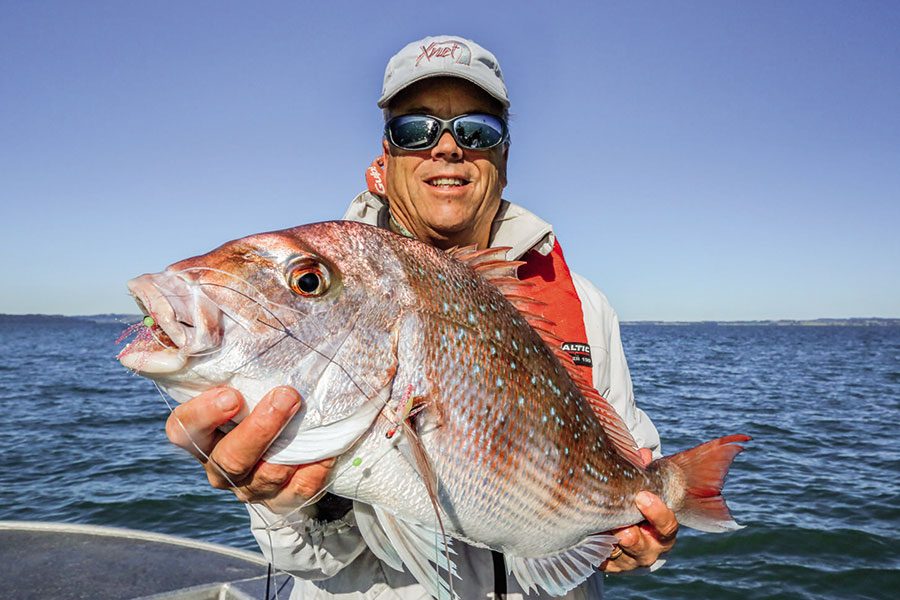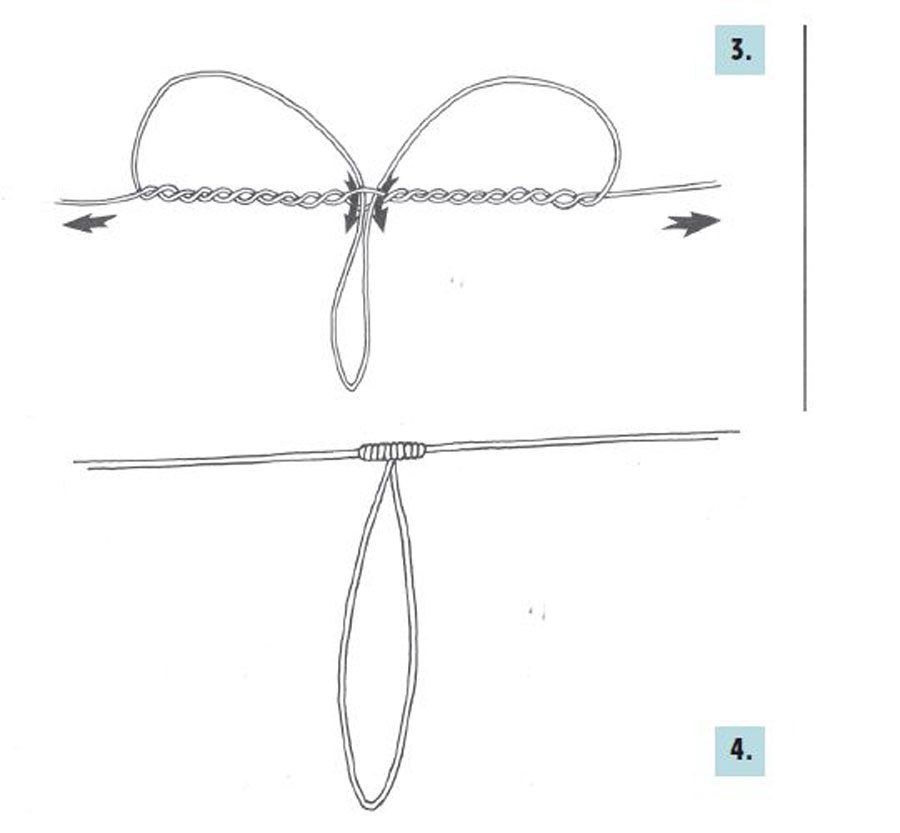

Novice anglers who read last month’s Boating NZ may now be the proud owners of a new spinning outfit and destined (hopefully) for ‘bait-fishing greatness’.
The simplest way to get a return on this investment is to use a ledger or dropper rig. This consists of a streamlined sinker tied to one end of the leader, a swivel on the other end, with two single hooks on branching droppers between them (see diagram 1).
This rig is generally lowered straight down and is better used in water 20m deep or deeper – fish generally dislike having a boat casting a shadow over them and making strange noises, both more noticeable in shallow water. However, murky water and/or a decent current flow can disguise the presence of the boat so that ledger fishing in shallower conditions still works well.
Fishers who plan to use dropper rigs will likely have a few pre-made – it’s possible to tie them up them at home or buy them ready-made from a fishing tackle store. Ideally, novice fishers should make their own, as learning the basic knots is an essential part of the fishing journey.
Two knots are used to make ledger rigs: the dropper knot and the uni knot (see diagram processes 2 and 3). The uni knot is especially important as it can connect a wide variety of tackle to monofilament or fluorocarbon line of any breaking strain.


Step 1. Form an overhand loop then rotate the tag-end around the loop, as illustrated. (Note: The dropper should not be too long, but make the loop a bit bigger than you think it needs to be – around the diameter of a saucer should do the job.)
Step 2. i) The loop will feed through the twists more easily if the middle twist is kept open with your other hand’s thumb and index finger. ii) Pinch the loop between your thumb and index finger to make it slimmer, then feed through the middle of the twists.
Step 3. i) Hold the tip of the loop in your mouth before pulling the standing line on either side of the loop so the twists start to snug up. ii) Release the loop from your mouth and continue pulling on both ends of the standing until the twists become tight.
Step 4. The finished dropper loop.
DIY DROPPER RIGS
TRACE LINE
I recommend using nylon rather than fluorocarbon to tie this rig, as it’s easier to tie knots in.
The trace line used needs to be thicker than the main line so it can resist fish teeth and abrasion from unforgiving ground.
Unfortunately, badly-tied dropper knots cut into themselves, drastically reducing the breaking strain (up to 50% for dropper knots/loops) of the trace line, made worse by the tightened knots’ tendency to steadily lose strength over time. Consequently, 24-27kg (50-60lb) trace is commonly used, and the strongest rigs are tied the night before.
If fishing in high current areas, where heavy weights and tackle are required and perhaps rays and sharks are regularly encountered, ledger rigs may even need to be made from 37- 45kg (80-100lb) trace.
Deep water ledger rigs for hapuku and bass are tied from even heavier trace.
THE SINKER
When snapper fishing we generally use the lightest sinker necessary to get our baits down, but ledger rigs are an exception. In this style of fishing some extra weight can be beneficial, as it helps to set the hook – especially a circle hook – into a fish’s mouth (more on this soon). A 6-8oz sinker does nicely in water over 30m deep.
The sinker’s shape is important, too. Long, streamlined models sink quickly and are less likely to snag up.
The sinker should be no closer than 30cm from the dropper loop above it or snagging the bottom hook can be a problem. But don’t make this part of the trace too long either, as most snapper tend to hold near the seabed, out of the worst of the tidal flow.
THE SWIVEL
The swivel needs to be strong enough with wire attachment loops thicker than the nylon trace, otherwise the nylon cuts into itself.
Dropper loop knots
Tie the trace’s branching dropper loops so they stick out at right angles from the backbone and are far enough apart the hooks cannot catch up with one another. Droppers should be tied short enough so they don’t flail or twist around the backbone when the rig is lowered or retrieved.
Hooks
I recommend using recurved or circle hooks, especially if using nylon monofilament line in deep water and/or in areas with lots of current. Nylon is very stretchy, making bites hard to detect. Since recurved hooks only require a little tension on the line to slide into the hinge of a fish’s jaw, anglers often hook up without even feeling the bite. However, should bites be felt, a slow, steady lift is all that’s required. A hard, fast strike, on the other hand, can easily bounce a circle hook right out of the fish’s mouth!
The ideal hook size is hotly debated, but I find a 5/0 circle hook will accommodate a bait that’s big enough to entice and catch a pretty decent snapper, but the hook is small enough to catch lesser but still legal fish.
Recurved hooks must be attached correctly to the dropper loop to realise their full potential. Thread the dropper loop through the front of the hook’s eye (i.e. on the point and barb side) before looping it over the hook’s point and bend. That way the hook’s incurving form is exaggerated still further when the loop is pulled up tight. Looking at it, you might wonder how fish will find the hook’s point, but catch fish it does!
Rig accessories
Tests have shown that fish detect fluorescence and luminescence more keenly than humans. So luminous materials – usually in the form of plastic or rubber beads – help the rig stand out when fishing in deep or murky water and during the hours of darkness.
Thanks, but no thanks!
Having said all the above, there are some excellent premade dropper rigs on offer in tackle shops. Black Magic and Gamakatsu are good examples. On the flip side, beware of very cheap rigs – these could fail when you least want them to.
BAITING UP
Dropper rigs work best with small/slim/short baits hooked through just once. Examples include multiples of shellfish, halfpilchards, squid-tentacle clumps, and strips of squid or fish.
The following baits are commonly used:
The head half of a pilchard (cut at an angle so the bait seems longer and is easier to swallow): push the hook through the bony section in front of the eyes, or up between the gills and out through the skull.
Strip baits (tough and/or oily baits such as skipjack tuna, mullet and kahawai are best): cut them into slender, tapered strips and place the hook just once through the fatter end.
Squid-tentacle head clump (medium-sized ones are usually best): push the hook down through the head clump once so the hook point exits among the tentacles. Divide big clumps lengthwise into two baits.
Whatever you use, hook the bait just once to avoid choking the hook’s gape, which makes hook-ups difficult.
FISHING THE RIG
Simply drop the ledger rig to the bottom, engage the reel and with the sinker still on the bottom, wind in any slack line.
When a fish bites, slowly lift the rod. If itcontinues to bend, keep the pressure on and start winding, perhaps also lifting firmly, to make sure the hook is well-seated. Too easy! BNZ

1. The basic two-dropper ledger rig – simple and highly effective
2. Squid tentacle clump on a circle-hooked ledger rig.
3. Strip baits for ledger rigs.




